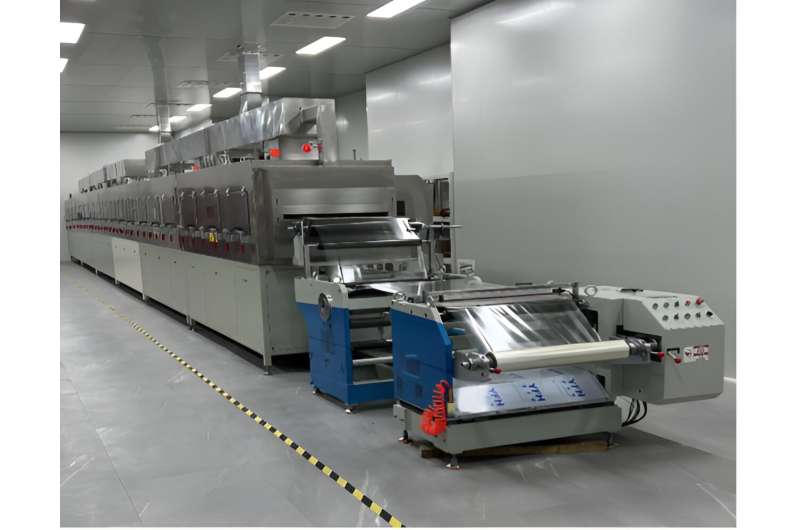January 30, 2024 feature
This article has been reviewed according to Science X's editorial process and policies. Editors have highlighted the following attributes while ensuring the content's credibility:
fact-checked
peer-reviewed publication
trusted source
proofread
A method to fabricate long rolls of subnanocomposite dielectric polymers

Engineers and material scientists have been trying to develop increasingly advanced devices, to meet the growing needs of the electronics industry. These devices include electrostatic capacitors, devices that can store electrical energy in a dielectric between a pair of electrodes through the accumulation of electric charge on the dielectric surfaces.
These capacitors are crucial components of various technologies, including electric vehicles and photovoltaics (PVs). They are often fabricated using polymers as dielectric materials, synthetic substances made up of large organic molecules with good intrinsic flexibility and insulating properties.
Researchers at Tsinghua University and other institutes in China recently introduced a new strategy to fabricate polymer composites filled with subnanosheets exhibiting highly advantageous properties. Their proposed method, outlined in a Nature Energy paper, allowed them to fabricate a 100-meter-long roll of a polymer-based subnanocomposite film.
"We have paid attention to polymer-based subnanocomposites for years, in cooperation with Professor Xun Wang, from Tsinghua University's Department of Chemistry," Yang Shen, co-author of the paper, told Phys.org. "Our research [focuses] on the capacitive energy storage of polymer dielectrics, which requires the high polarization, resistance to breakdown and suppression of charge migration especially at high temperatures."
Subnanomaterials are materials with at least one dimension below 1 nm in length. These materials can take various shapes and forms, such as subnanowires, subnanosheets and subnanobelts. Past studies have found that subnanomaterials can exhibit various novel characteristics and properties, which make them promising fillers for composite dielectrics.
"First, thanks to their comparable sizes to polymer chains, i.e., 1 nm, subnanomaterials show great flexibility, which means that they can adjust their shapes to eliminate the interfacial voids and merge a dense interface in composites," Shen explained. "In addition, subnanomaterials have the surface atom ratio of nearly 100% and ultra-large specific surface area, which give rise to much more remarkable interfacial phenomena than nanofillers, such as charge trapping and breakdown path hindering."
Polyoxometalate (POM)-based subnanomaterials are typically fabricated by assembling POM clusters in one or two dimensions. The unique structure resulting from this process allows these materials to capture and store many electrons via a reaction known as metal cation reduction, thus providing an alternative and promising approach to convert electrical energy in dielectric devices.
"In recent years, we have attempted to employ subnanomaterials as fillers and studied polymer-based subnanocomposites," Shen said. "Initially, we focused on subnanowires and have found the unexpected enhancement of polarization. In this recent work, we turned our attention to subnanosheets and a substantial improvement of breakdown strength were emphasized."
The researchers have been trying to fabricate high-quality polymer subnanocomposites for a while now, as they first had to overcome several technique hurdles. First, they had to identify suitable solvents for synthesizing the materials.

"The proper solvents for polymers and subnanomaterials are totally different, i.e., N,N-Dimethylformamide (DMF) or N-Methylpyrrolidone (NMP) for former and chloroform or cyclohexane for latter, respectively," Shen said.
"In the beginning, we chose chloroform as the solvent, yet its low boiling point and fast evaporation made the solution casting process of composite film very difficult. We then turned to DMF/NMP and encountered the improper distribution of subnanomaterials in them."
To overcome the challenges they encountered when using DMF/NMP solvents, the researchers employed various dispersion processes, such as vigorous stirring and the ultrasonic treatment of materials. This ultimately allowed them to ensure that the subnanomaterials were uniformly dispersed in their films.
Ultimately, Shen and his colleagues were able to realize high-quality subnanocomposites with a filler content below 1 wt% and found that this was enough to significantly improve their materials' dielectric performance, enabling an ultrahigh Ud of 7.2 J cm−3 with a charge–discharge efficiency of 90% and charge–discharge cycle stability up to 5 × 105 cycles at 200 °C .
"Different from traditional nanocomposites, our subnanocomposites still have excellent flexibility, which suggests its wide prospects for industrial roll-to-roll fabrication and application with multiple configurations," Shen said. "In addition, subnanomaterials have been proved to have improving effects in many common heat-resistant polymers, further confirming its generality in capacitive energy storage."
As part of their study, the researchers were able to fabricate a 100-meter-long roll of a subnanocomposite film using solution casting equipment built in their laboratory. Remarkably, their fabrication method appears easy to scale up, and could thus enable the roll-to-roll continuous fabrication of subnanocomposites.
"As for traditional nanocomposite dielectrics, due to the high content rigid inorganic nanofillers, there are several defects and voids at interface," Shen said.
"During the roll-to-roll fabrication, these interfacial defects will form microcracks, which largely deteriorate the flexibility and hinder the industrial manufacturing of these nanocomposite films. In contrast, our subnanocomposites maintain great flexibility and have dense interface owing to the intrinsic flexibility and good interfacial compatibility to polymers of subnanomaterials."
Shen and his colleagues found that the 100-meter-long polymer-inorganic subnanocomposite they produced exhibited stable energy storage performances and reliable properties. In the future, they hope that their proposed methods will enable the large-scale fabrication of subnanocomposite dielectric materials, which could facilitate their integration in various devices.
In their next studies, the researchers plan to continue exploring the fabrication of polymer-inorganic subnanocomposite materials for energy storage capacitors. In addition to further improving the performance of subnanocomposites, they hope to increasingly simplify their production.
"On one hand, we will continue to explore the interaction between polymers and inorganic fillers at subnanoscale and demonstrate its impact on capacitive energy storage," Shen added.
"It has been found that the subnanoinorganics exhibit excellent structural compatibility and similar scale as polymer chains, inspiring us to introduce chemical bonds between them and form the hybrid dielectrics without interface. On the other hand, we also hope to promote their mass production and application in film capacitors."
"Although subnanocomposite showed promise for the roll-to-roll continuous fabrication of dielectric film, there are still many obstacles for us to overcome, such as high cost of raw materials and time-consuming synthesis of subnanomaterials."
More information: Minzheng Yang et al, Roll-to-roll fabricated polymer composites filled with subnanosheets exhibiting high energy density and cyclic stability at 200 °C, Nature Energy (2024). DOI: 10.1038/s41560-023-01416-3
Journal information: Nature Energy
© 2024 Science X Network




















